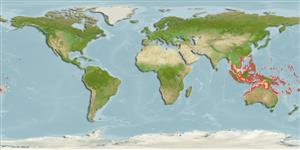Preferred temperature (संदर्भ
123201): 24.7 - 29, mean 27.9 °C (based on 628 cells).
Phylogenetic diversity index (संदर्भ
82804): PD
50 = 0.5005 [Uniqueness, from 0.5 = low to 2.0 = high].
Bayesian length-weight: a=0.02951 (0.01904 - 0.04574), b=3.01 (2.88 - 3.14), in cm total length, based on LWR estimates for this species & (Sub)family-body (Ref.
93245).
Trophic level (संदर्भ
69278): 2.6 ±0.1 se; based on diet studies.
लौटाव (संदर्भ
120179): ऊंचा, न्यूनतम जनसंख्या दुगनी समय अवलागत 15 महीने। (Preliminary K or Fecundity.).
Fishing Vulnerability (Ref.
59153): Low vulnerability (10 of 100).
🛈
Nutrients (Ref.
124155): Calcium = 109 [54, 183] mg/100g; Iron = 0.883 [0.518, 1.503] mg/100g; Protein = 17.9 [16.7, 19.1] %; Omega3 = 0.114 [0.064, 0.196] g/100g; Selenium = 25.9 [12.4, 54.4] μg/100g; VitaminA = 130 [34, 493] μg/100g; Zinc = 1.69 [1.11, 2.53] mg/100g (wet weight);
